Through our privately funded aquisition program, VMFA regularly aquires significant pieces
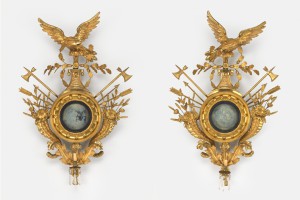
Pair of Girandole Mirrors, ca. 1810–1820, Unknown Artisan (Albany, New York), various woods, carved, gessoed, and gilded, with ebonized framing around mirrors; iron wire, gilt brass, mirror plate, and cut glass prisms, 37¾ x 25½ x 7¾ in. and 38½ x 24¾ x 7¾ in. Floyd D. and Anne C. Gottwald Fund
to be added to our permanent collection. We welcome you to visit and enjoy recent aquisitions such as these at the museum.
This singular pair of girandole mirrors is a spectacular manifestation of decorative arts as sculpture. The unusual inclusion of Native American motifs—arrows, spears, tomahawks—was inspired by New York’s rich Native American history, which had an enduring impact on regional lore, inspiring such works as James Fenimore Cooper’s 1826 bestseller, The Last of the Mohicans. At the same time, the mirrors evoke the complex narrative of antebellum “progress” born of immigration, westward expansion, and expanding economic opportunities.
— Dr. Susan J. Rawles, Assistant Curator of American Decorative Art
Beauford Delaneyis critically acclaimed for his modern portraits, of which Marian Anderson is his most ambitious and accomplished. Characterized by a chromatic brilliance and technical complexity, the painting of this iconic contralto and cultural hero epitomizes the artist’s exploration of abstractions that featured the color yellow as a symbol of perfection and transcendence. Marian Anderson is the first painted portrait of a celebrated historical black figure to enter VMFA’s collection.
— Dr. Sylvia Yount, Chief Curator and Louise B. and J. Harwood Cochrane Curator of American Art
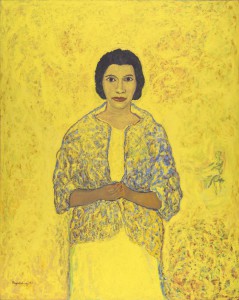
Marian Anderson, 1965, Beauford Delaney (American, 1901–1979), oil on canvas, 63 x 51½ in. J. Harwood and Louise B. Cochrane Fund for American Art
Born to a merchant family in Zhenjiang, Zhang Yin was a talented painter of all genres, especially landscapes and pine trees. Inspired by Ming-dynasty artists Wen Zhengming and Shen Zhou, Zhang is known for his use of elegant colors and intricate details. In this painting, he realistically depicts a village scene on a water bank, showing mountains in the distance. Zhang’s paintings are rare; another fine example is in the collection of the Palace Museum in Beijing.
— Li Jian, E. Rhodes and Leona B. Carpenter Curator of East Asian Art
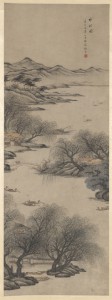
Water Village, 1827, Zhang Yin (Chinese, 1761–1829), Qing dynasty
(1644–1911), Hanging scroll; ink and color on paper, image: 52½ x 19 in. Margaret and Arthur Glasgow Art Purchase Endowment and partial gift of the Y. T. Bay Collection
This pair of scrolls comes from a collection of Chinese calligraphies and paintings assembled by Mr. Y. T. Bay (1913-1987) in Hong Kong during the 1960s and 1970s. VMFA recently acquired 125 works from the Bay Collection, including four calligraphies by Zhang Yuzi, a scholar of the late Qing dynasty. This couplet reveals the artist’s fascination with the 2nd-century Cao Quan Stone Tablet, known for its orderly composition, balanced form, and varied brushstrokes.
— Li Jian, E. Rhodes and Leona B. Carpenter Curator of East Asian Art
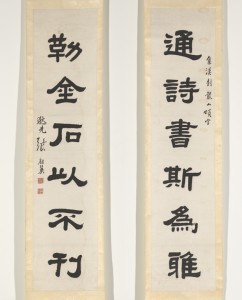
Six-Character Couplet in Clerical Script, Zhang Zuyi, (Chinese, 1849–1917), Republic period (1911–1949), pair of hanging scrolls; ink on paper, image: 48 x 11 in. Margaret and Arthur Glasgow Art Purchase Endowment and partial gift of the Y. T. Bay Collection
The inscription on this image by prominent Chinese modern artist Li Kuchan describes a scene from his own garden, where his neighbor’s gourds grew over the wall. The expressive cursive calligraphy and the bold, spontaneous washes for the vegetation demonstrate the artist’s masterful skills with ink and brush, as well as his ability to integrate calligraphy into painting. Born in Shandong, Li studied painting with Qi Baishi and taught at art schools in Hangzhou and Beijing.
— Li Jian, E. Rhodes and Leona B. Carpenter Curator of East Asian Art
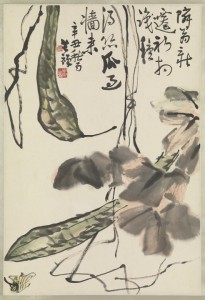
Gourds, 1961, Li Kuchan (Chinese, 1899–1983), People’s Republic period (1949–present), hanging scroll; ink and color on paper, image: 27 x 18 5/8 in. Margaret and Arthur Glasgow Art Purchase Endowment and partial gift of the Y. T. Bay Collection
Frank Raysor’s promised gift of approximately 10,000 prints will transform VMFA into a first-rate institution for the collection of works on paper. Among the Raysor treasures are in-depth holdings of artists associated with the late-19th century Etching Revival movement in Britain and France. Legros was foremost among that group and a specialist in both portraits and scenes of the macabre (including illustrations for works by Edgar Allan Poe). Deeply immersed in the upper echelons of the Victorian intelligentsia, Legros had the opportunity to paint portraits of eminent figures of the day such as Thomas Huxley—an early proponent of Darwinism. Legros will be the subject of a forthcoming VMFA exhibition, featuring his work alongside that of his pupil William Strang.
— Dr. Mitchell Merling, Paul Mellon Curator and Head of the Department of European Art
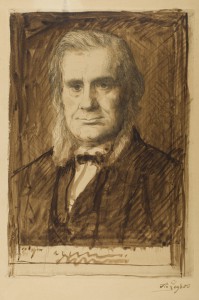
Portrait of Professor Thomas Huxley, ca. 1880–90, Alphonse Legros (English (born in France), 1837–1911), etching, with brown and black ink on brown wove paper (heavily touched proof), 16 3⁄4 x 12 3⁄8 in. Gift of Frank Raysor